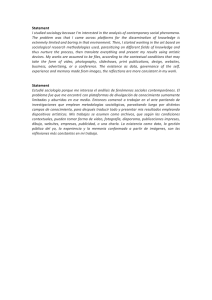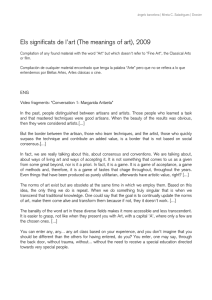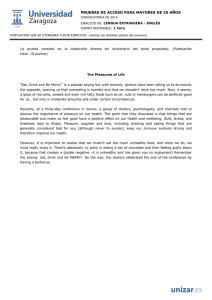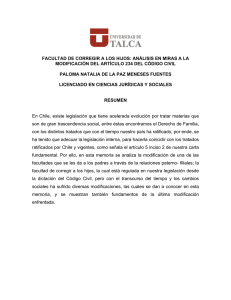Recuerdo un reportaje sobre la Revolución Rusa
Anuncio
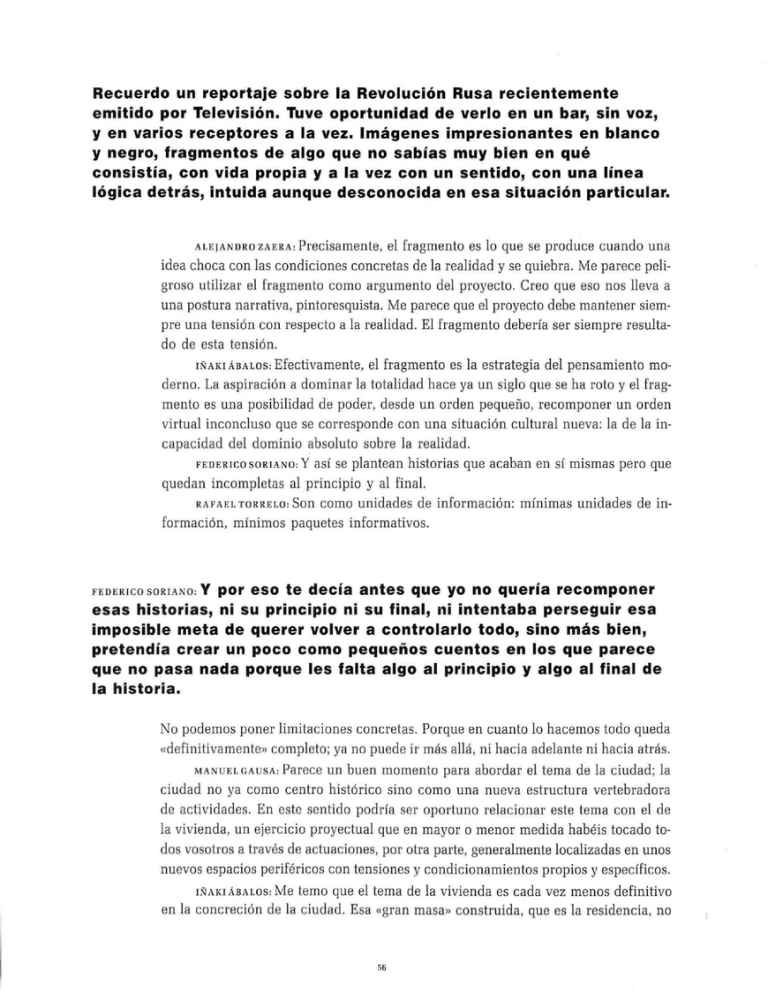
Recuerdo un reportaje sobre la Revolución Rusa recientemente emitido por Televisión. Tuve oportunidad de verlo en un bar, sin voz, y en varios receptores a la vez. Imágenes impresionantes en blanco y negro, fragmentos de algo que no sabías muy bien en qué consistía, con vida propia y a la vez con un sentido, con una línea lógica detrás, intuida aunque desconocida en esa situación particular. ALEJANDRo ZA ERA: Precisamente, el fragmento es lo que se produce cuando una idea choca con las condiciones concretas de la realidad y se quiebra. Me parece peligroso utilizar el fragmento como argumento del proyecto. Creo que eso nos lleva a una postura narrativa, pintoresquista. Me parece que el proyecto debe m antener siempre una tensión con respecto a la realidad. El fragmento debería ser siempre resultado de esta tensión. IÑAKI ÁBALos: Efectivam ente, el fragmento es la estrategia del pensamiento moderno. La aspiración a dominar la totalidad hace ya un siglo que se ha roto y el fragmento es una posibilidad de poder, desde un orden pequeño, recomponer u n orden virtual inconcluso que se corresponde con una situación cultural nueva: la de la incapacidad del dominio absoluto sobre la realidad. FEDERico soRIANo: Y así se plantean historias que acaban en sí mismas pero que quedan incompletas al principio y al final. RAFAELTORRELO: Son como unidades de información: mínimas unidades de información, mínimos paquetes informativos. FE DERico soRIANO: Y por eso te decía antes que yo no quería recomponer esas historias, ni su principio ni su final , ni intentaba perseguir esa imposible meta de querer volver a controlarlo todo, sino más bien, pretendía crear un poco como pequeños cuentos en los que parece que no pasa nada porque les falta algo al principio y algo al final de la historia. No podemos poner limitaciones concretas. Porque en cua nto lo h acemos todo queda «definitivamente» completo; ya no puede ir más allá, ni hacia adelante ni hacia atrás. MANUELGAUSA: Parece un buen momento para abordar el tema de la ciudad; la ciudad no ya como centro histórico sino como una nueva estructur a vertebr adora de actividades. En este sentido podría ser oportuno relacionar este tema con el de la vivienda, un ejercicio proyectual que en mayor o menor medida habéis tocado todos vosotr os a través de actuaciones, por otra parte, generalmente localizadas en unos nuevos espacios periféricos con tensiones y condicionamientos propios y específicos. IÑAK I ÁBALOS: Me temo que el tema de la vivienda es cada vez m enos definitivo en la concreción de la ciudad. Esa «gran masa» construida, que es la residencia, no 56 es más que el fondo neutro de otras emergencias que aparecen ahora, un residuo de prácticas constructivas antiquísimas. Creo que la ciudad se genera a través de otros canales y es a esos otros canales a los que hay que atender y sobre los que hay que insistir más; especialmente, todo lo que tiene que ver con las infraestructuras y sus terminales. Todo lo que es viario, canalizaciones, etc., etc., eso es en realidad el sustrato que está determinando la forma y el contenido de la ciudad, más allá de ese otro fondo neutro de la vivienda. La ciudad contemporánea está determinada más por los sistemas generales fundamentales que por la vivienda. Se tiene que entender el crecimiento urbano más en función de esa trama que reparte la energía o el transporte que en función del tejido residencial, del espacio público o del equipamiento urbano que habían caracterizado la ciudad del siglo XIX; la ciudad es ya otra cosa. JUAN H ERRERos: De hecho, el crecimiento del espacio para oficinas en Madrid es mucho más determinante ahora que el que pudo haber hace 20 o 30 años para la vivienda. La ciudad crece a impulsos, impulsos de las infraestructuras, impulsos de los grandes contenedores, impulsos de los nuevos centros de estallido. Y la vivienda, sin embargo, se ha quedado, mal que nos pese, reducida a una dinámica profesional infinitamente más lenta que el resto de edificios. El nivel de exigencia que se genera en torno a cualquier enclave terciario es muy superior al nivel de exigencia que genera la vivienda, seguramente por una cuestión social, anclada en la costumbre, con unos parámetros de bienestar heredados. Mientras que, en el trabajo organizado, los parámetros de bienestar evolucionan notablemente y los paradigmas como el clima artificial , la necesidad o no de luz natural, etc., producen unas coordenadas nuevas en cada momento, la vivienda permanece ahí anquilosada. En ese sentido creo que la vivienda se debe convertir, como se convirtió hace muchos años, en la depositaria de las experiencias practicadas en otros campos, en los que la arquitectura desarrolla sus sistemas hasta el final. FE DERI CO s oR I ANO: Evidentemente, la idea de centro se ha perdido y esta pérdida es la que hace qu e emerja, actualmente, la periferia. Sin embargo, todavía no parece existir el mecanismo nuevo que solucione esta dinámica y todavía sigue actuándose con la pequeña placita que intenta reponer el pequeño centro, pero que ya no puede, sin embargo, aglutinar la ciud ad. Entonces, ¿cómo quedan esos nuevos vacíos urbanos? RAFAELTORRELO: Hay una experiencia que me gustaría realizar: recorrer Madrid en coche, empezar por el Centro, dar vueltas hasta salir a la periferia y sin solución de continuidad cuand o la ciudad se acaba, en ese desconocido e impreciso momento en que ésta se diluye, pasar a la periferia de Barcelona o de cualquier otra ciudad. Creo que las diferencias no existirían; es la ciudad indiferenciada que plantea Federico. ALEJAN Do ZAERA: !17 o .. ·-.. .. :e THEORY -THE ITALIAN Tendenzo, HISTORICISM, ETC. Moderated by Alejandro Zaera and Manuel Causa with the participalion of Juan Herreros. 1i1aki A valos, Rafael Torrelo, Federico Soriano, Fernando Porras, and Mateo Corrales. . :¡: M THEY ENDED UP SATURATEO WITH THEORY ANO LACKI NG PRACTICAL EXPERIE NCE. Cl) .e e en u Cl) u ~ 4 IÑAK I ÁBA LOS: Almost all affirmations are made th rough negations; it's much easier to pick out what you don't identify with than what your references are. We' re almost all against the «navelism» of the so-called Mad rid school, aga inst all these kinds of altitudes that a ttempt co ntinually to iden tify with a local context. As regards those who were our teac he rs, perhaps we're a lso rather against their influence simply because the situat~o_n is different now. Their «accursedness» -the condttiOns that sorne of the m suffered and others continue to foster- may have been essential to maintain ing a personal attitude, but it reflects this retreat from reality which is very different from altitudes we can hold today. JUAN HERREROS: Yes. It's easy to see how today th ere's a series of professionals whose in tentions right now are directed towards a commitment to reality; and when you look back over the architecture of our predecessors you find the generation Mateo Corrales and Iñaki Ábalos have talked about, and there's no direct co ntact w ith them because they didn't experience this commitment, perhaps because a t that time there were no coordinates w ith which to pose the issue of a relationship with the constructed wo rld, w ith the built city. Going further back you come ac ross de la Sota, and it seems as if the pendulum has swung right back again, but if you go even further back, you might find de la Sota's own references. It's more difficult to t hink that de la Sota could really be a co mmon or consciously shared reference th an to thin k th at the circumstances tha t moved de la Sota to actas he did are the sa me ones mov ing us now. In any case, I agree with Mateo th at specifically madrileño a rchitects or a rchitecture are moving towards an increasingly perso nalised stance; bu t I don't think this is a particu lary good thing. MATEO co RRALES: IndividuaJism, like contradiction, is neithe r good nor bad; it's something which in genera l terms is more visible today rhan in the past, and we ha ve no choice but to accept and make use of it. FEDER ICO so RIANO: !'m not sure whether the word «individualism» is the appropriate one h ere; 1 think it's more that each one end s up adopti ng a singular stance in each work, each project. MAN UE LGAUSA : Co ntra ry to othe r more sceptical or accommodating stances in our architecture, it would seem that in you r case what prevails is the exciting possibili ty to keep on experimenting, accepting (beyond a prudent adaptation to context or arguments based on histo ry or memory) th e encounter with objective reality, with the challenges and changes of o ur contemporary la ndscape. In your projects it's possible to detect a new tone in w hich there's a mixture of a certain anti-sentimentalism, a dryness of language (even in the drawings) which is distant, even disdainfu], arising out of minuteness, which 1 believe reflects the destruction of that anecdote that characterises other architectures that need crutches and al ibis. JUAN HERREROS: I'd define it as an att e mpt at immed iacy. All that collec tion of chained details that have fed recenl a rchi tecture for a long period, that nostalgia for the anecdotic, for fragmentation, has led to two bis present disc ussion is an attempt to exami ne the most rel eva nt aspects of what might be described as a certain «shared tone» revealed in your respective p ro fessio na l careers. You al! practice in Madrid and are a l! about the same age and, although we cannot speak strictly about a common line of thought, there does seem to be a vital a ttitude a nd con fidence in the profession and compromise with an idea of progress w hich links to other altitudes, emblematic at their time, in th e world of Madrid archi tecture, reflected both in the production of Ale jandro de la Sota and in the subseq uent work of certain professionals who had clase links with him and with w hom so rne of you have been associat ed. Despite the fact that it might be too literal a way to get the discussion going, we might begin by looking at the real influence of these references in your fo rmative periods. MATEO CORRA LES: I get the impression that we architects are constantly searching for lines of thought that would justify the type of architeclure we p roduce. Perhaps th is kind of classification has less reason fo r existing today. Architecture can as far as possible cont inue to be an individual a nd singular activity for the architect without necessarily losing its collective condition . It's difficult to talk of tendencies and even more so to speak of references in our formative periods, above all in Madrid. Here, du ring the transformation period, radical cha nges took place in the teachi ng profession, so that in fl uences were practically non-ex istent. Collectives o r groups don 't exist as such. Obviously in my case there necessary references and 1 th in k examples from the generation of my father, Molezú n, De La Sota, Vázquez de la Costa a nd so many others, were and continue to be important. t OUR GENERATION , I F WE CAN CALL IT THAT, IS FUNDAMENTALLY SEARCH ING FOR WAYS TO EXERCISE THE PROFESSION, TO CONSTRUCTOR MAKE, ANO TH IS MEANS THAT OUR MAJOR REFERENCE IS PRAGMATISM ANO REAL DISCOVERIES AS ARCH ITECTURE MA- TERIALISES. 1 BELIEVE THE MASTERS YOU REFERRED TO, SOTA ANO EVEN OIZA, LEARNED ABOUT ARCHITECTURE BY PRODUCING IT, ANO IN THIS SENSE 1 THINK THEY WERE ABLE TO PRODUCE A GREAT AMOUNT OF ARCHITECTURE PRECISEL Y BE CAUSE THEY HAO THE OPPORTUNITY TO DO SO. ON THE OTHER HAND, THE GENERATION OF OUR TEACHERS - THOSE WHO ARE NOW I N THEIR FORTIES AN O FIFTIES- HA RDLY HAO THIS CAPACITY OR OPPORT UNITY TO CONSTRUCT. TH EY WERE SMOTHEREO BY 58 En este sentido, creo que hay que volver a hablar de vivienda porque creo que es un gran debate que estamos rechazando y no debemos hacerlo. Nos va a pasar como al arquitecto del siglo XIX con la infraestructura: rehusó intervenir en ella y se la apropiaron los ingenieros. El mayor espacio urbano que tenemos en Madrid es el de la M -30. Defiendo retomar ese espacio urbano e intervenir en él. Pero sin dejar de lado la vivienda porque entonces ésta se convertiría en pasto del especulador, en pasto del decorador, en pasto del h ort era sin nombre. Aunque el planteamiento general respecto de la vivienda sea totalmente regresivo, aunque parezca inviable la po sibilidad de hacer un nuevo espacio habitable, aunque predominen esos factores sociales y económicos que nos impiden ser abiertos en nuestros planteamientos. IÑAKI ÁBALOs: Creo que lo único que podemos hacer en este tema los arquitectos es barrer la casa, eliminar, quitar, limpiar la vivienda y dejarla absolutamente disponible. Las dos únicas alternativas que yo conozco, en este siglo (propuestas auténticamente nuevas) son el famoso módulo de Le Corbusier y el 1oft que tanto éxito tiene en las ciudades americanas y, que al fin y al cabo, es un tipología industrial reciclada . Y creo que lo que hemo s de hacer es trabajar en esa dirección: dejar los espacios con grandes planos de contacto con el exterior, con un equipamiento lo más periférico posible para que no interven ga y no sea u na obstrucción; y poco más . Pienso que es más importante analizar cómo se desliza la demanda hacia tipos m ás extremos que los típicos que hemos heredado del Movimiento Moderno centroeuropeo. Creo que, por una parte, la demanda del suburbio (ese intento tan denigrado de la casa en pastilla) tiene unas hondas raíces en las necesidades del hombre moderno; y, por otra parte, para aquel que viva dentro de la ciudad, cada vez ha de tenderse más hacia tipologías estratificadas, tipologías mixtas en las que los usos de vivienda se mezclen con otros usos, secciones de ciudad en que la disposición de la vivienda, insisto , no sea determinante. Así pues, hay que ir hacia la construcción en alturas estratificadas y hacia los suburbios, entendidos como los entienden los ingleses o los americanos y no como los entendemos aquí. Esos dos tipos son probablemente los más intensos. Pertenecen a sociedades mucho más avanzadas, en las cuales se trabaja mucho más en casa. Esto es mañana o pasado mañana, y creo que h ay que asumirlo ya. J UAN HERRERo s: Hay un ejercicio pendiente: lo que Iñaki y yo llamamos «la vivienda que aún no tenemos»: sentarse y establecer cúal es la vivienda de la que aún no se puede disponer, que no está actualmente en oferta. Nadie puede hoy disponer en Madrid de una vivienda en la que llevar simplemente una forma de vida o desarrollar una estructura familiar diferentes de las establecidas por la normativa. Hacen falta lugares aislados de reflexión o de estudio en la vivienda, menor determinación 59 field of art, wh ic h is difficul t t o transmit si n ce it's an individu al experie nce, as in that of the other kind of sc ientific tec h niques th a l have a c onsc ious p rocess that can be stud ied and unde rstood. Therc's a his tory of sc iences in w hi ch Juan and 1 a re becoming mo re and more in lerested (al the momenl these are p ractically the only kind of books we're reading) in wh ic h things are modified q ua li tatively al the moment w hen others appear that oblige the individual to cha nge his way of thinking an d evolve. Of course, there's a nother , m ore literary way of rcading a rchi tecture, more p ictu res que even, bu l pe rso na ll y il doesn' t in tercst me. MANUEL GA USA: Earlie r Juan spoke aboul the fragment, refe rri ng to th e idea of divis ion in to plots, limits a nd what is p e rso na l. Nevertheless, the re's another m eaning of the fragment in con tem po rary thought tha t interests me parti culary. !' m thinking about so methi ng Wim Wenders sa id in iss ue no . 181 of «Quade m s», in a n interview wi th Hans Kollhoff: «Whal is fragm e nted (or broken) has a rough s urface lo wh ich we can cling. On the smooth s urface of completeness we sl ip.» In some o f your projecls (1 refer, fo r exa mpl e, lo Mateo Corrales', Aluche sports complex, Ra fael Torrelo's plan for the banks o f the Guadiana, Federico Soriano and Fernando Porras', competit ion project for the Santander maritime promenade or Iñaki Aba los and Juan Herreros', large-scale in te rventions) th is presence of fragmen tation appears as the negation of total co mpletion, as the poss ible use of dislocated mater ial or even e lem ents that a ppea r s pontaneous ly asan allernative to other m o re scen ogra phi ca l ope rations prod uc ing complete, cl osed a nd fever is hly d etailcd solutions. JUAN HERR EROS: They' re very d iffe rent fragments. The idea of frag m ent that excites Wenders so much is somethi ng that had been complete and which, like Europ ean c ities, remains co nsc iously incomplete; frag ments thal were never inte nd ed to be any thing in the mselves. ALEJA NDRO ZAERA: I'd rather thi nk of them as <<Ínterrupted disco u rses » than fragm e nts or rui n s. 1 thin k the most inte resting aspect is p recisely the moment o f d isorder that rea li ty in troduces in to the p ro ject, the random factor tha t co nc rete cond itio ns impose upon p lans. RAFA EL TORR ELO: 1 think this m igb t be SOmething like the «improbability» of what you may find whe n you put your fin ge r on a m ap w ithout looking, fo r example. 1n th e specific case we were talkin g about ea rlier, of the left bank of the Guad iana in Mér ida, the sca le of the inte rvention was rela ti vely grand, and copin g w ith it involved a certain amount of radomness. Bu t the fragment wa s always pa rl of a broader rea li ty . The idea was to establi sh a dialogue wi th th e historical ci ty, c reating a series of pla ns descending towards the l'i ver, o n w hic h complete or incomple te or even (why not?) ra ndom fo rms wcre dcvclopcd. things: on th e on e ha nd , a pemic ious view of genera l lo particular wh ich has produ ced intenelations of a l'ch itecture from the viewpoint of processes alien to our fie ld, and o n the other , the prese nce of acco mmod ati ng discourses, adap tation lo the s urroundings , th e weight of memory, cons truc tion-form adaptation and the consequent minute eva luation of deta il, etc. l mmediacy is agains t al! that: immediacy in co ns truc tion , immediacy in ideas and immediacy in putting them into prac tice. On thc o th er hand, l'm becom ing inc reasingly convinced that in arch itecture one must have a s uperimposed vision of the different sca les . lt's easy to see th at almost al! the a rchitec ls we admire have this ability lo reflect simultaneously on the general a nd the particular. Architectures like tha t of Le Co rbus ier , w ho had the w hol e of Pa rís in his h ead , even when he was d es igning a small detai l, or mo re recent archi tectures such as Norman Foster's, are teach ing us conslant lessons in this re spect. An attempt must be mad e lo understand that eac h ele ment mus t contain the id ea o f the project as a whole. MATEO COR RALES: l'm more scepti ca l about ge n era l stateme nts: l'm not quite sure how to tackle them. Befare we were talking about the importa nce of the commun ication m ed ia, of n ew systems, and so lo complexity we have Lo add the dimension o f phenomena and things. But architecture, like man, w ill co ntinue to be the same: a detemin ed expe rience and field in s p ec ific positions and econ omies. JUAN ~IERREROS: We' re talking about reflection , whic h can be carried out in ways w hich a re not necess arily individual. l nd eed , the tran s formation of our c ities, the de mand for n ew typologies, the presence of great infrastructures, the cha nges in sca le we're w itnessing, a l! of these are collective problems thal require discussion. 1 stillthink we have to superim pose these reflection s o n the co mpl ete project: the fenced-off field o f our ow n prívate re fl ec tio n can not limit itself to those aspects o f ou r work th at ha ve created th e mylh o f architecture, its physical presence. 1 believe tha t th e privatization of reflec ti on is som ething to be limited as much as possible, above a l! in projects. 1 beli eve th a t the later th is pri va tization reaches a projec t, th e more ene rgetic th e !alter will be, the later il w ill fall vict im lo specific demands, to th e eterna! pretexts that justify the weakness o f id eas that in the long run become d iluted. IÑAK I ÁBALOS: UNFORTU NATELY WE'VE BEEN CONDITIONEO TO UN D E RSTANDI NG THE PROCESS OF FORMALJSING ARCH ITECTURE AS A NARRATIVE PROCESS, AS IF A BU ILDING WERE A TEXT. l ' M THOROUGH LY AGA INST THIS NARRATIVE CONCE PT OF ARCH ITECTURE. I N EVERY DECISION THE THREE POSSIBLE SCALES MUST BE 1 REMEMBER A REPORT ON THE RUSSIAN REVOL U- FUSED , FROM THE CITY TO THE PROjECT, FROM THE T ION TH EY S HOWED RECENTLY ON TELEVISION. 1 SAW PROJ ECT TO THE CONSTRUCTION , I N AN I NTEGRAL IT IN A BAR , WITH THE SOUN D T URNED OOWN , ANO ON TECHNICAL THOUGHT, I N A SINGLE THOUGHT. SEVERAL SC R EENS AT ONCE. IMPRESSIVE IMAGES IN Fo r me thi s would be the di!Tcrcncc between altitudes more concerned with the concre te and altitudes th at alte m pt lo have a greater effect o n reality, placing architecture nol so muc h in the vaporous, diffic ult lo generalisc, BLACK ANO WHITE, FRAGMENTS OF SOMETHING YOU DIDN'T REALLY RECOGNISE, WITH ITS OWN LIFE ANO, AT T HE SAME TIME , WITH A MEAN ING , WITH A LOGICAL till de los usos, mayor adaptabilidad en el tiempo a los cambios. Por ello, cuanto más barras la casa, más se podrá intervenir luego en esa vida propia de los espacios a la que poco podemos añadir los arquitectos una vez hemos acabado nuestra labor. Y ahí está la lección de los edificios de oficinas. MANUEL GAUSA: Después de una etapa ensimismada en la pequeña dimensión parece como si el arquitecto comenzase a aceptar nuevas escalas de trabajo; la posibilidad de actuar sobre el territorio, el contacto con otras disciplinas como la ingeniería, el propio diseño de las infraestructuras, son campos que algunos de vosotros habéis abordado: las depuradoras de Iñaki y Juan o, de manera más tangencial, las centrales de autobuses de Rafael ilustrarían esta preocupación. ¿Cómo planteáis esta nueva relación con la gran escala?. I ÑAK I ÁBALOS: La escala territorial pertenece al dominio del arquitecto. La colonización del territorio le ha pertenecido siempre. Forma parte, claramente, de nuestro trabajo. Vuelvo a retomar el problema del viario como un problema arquitectónico, como un problema de construcción que ya no pertenece tan sólo a esa figura artificiosa que es el experto en tráfico. A Juan y a mí nos ha tocado trabajar fre cuentemente en situaciones de borde, en eso que se entiende por las puertas de la ciudad. Y el problema característico con el que te encuentras entonces es el de la asimilación de dos geometrías muy diferentes; la geometría de alta velocidad, la geometría sin cruces, lineal y fluida, que coge la curvatura del tráfico rápido y la de la trama más o menos isótropa que caracteriza la malla urbana. Para no sotros, el problema ha sido, fundamentalmente, el de entender esta situación y el de abordarla con instrumentos arquitectónicos, entendiendo el trazado viario como una experiencia urbana. Esa fusión de geometrías, esa fusión de tráficos, ha de realizarse de una forma menos aleatoria, menos banal, que como se suele producir normalmente. En el caso de Santander, especialmente, o en Puerta de Hierro, en un trabajo que hicimos para Agroman, el problema fundamental era éste: el intentar entender esa nueva posibilidad que existe entre tipología y viario, esa importante cantidad de arquitectura que hoy en día se puede entender como protuberancia, como terminal de una infraestructura en la que los límites entre lo que es específicamente infraestructura y lo que es edificio se van deshaciendo progresivamente. Aparcamientos, Centros Comerciales, Centrales Depuradoras, tipologías que son campos terminales de nuevos trazados. ALE JANDRo ZAERA: Antes hablábamos precisamente de que la ciudad contemporánea , la metrópolis, se caracteriza fundamentalmente por esos sistemas de transporte o de distribución de energía, que permiten su «funcionamiento». Esto es algo que tiene mucho que ver con la forma usual de actuar sobre el territorio. ¿Se ha convertido la ciudad en un nuevo territorio, objeto de «colonización» más que de «urbanización»? ¿Cuáles son los límites, las diferencias entre ciudad y territorio? ¿Cómo se producen? ¿O acaso estas fronteras se han diluido, y la relación es de continuidad, de conexión? I ÑAK I Á BALas: La ciudad estalla, pero tampoco hay que hacer grandes panegíricos. Joan Busquests lo decía muy bien en una reciente conferencia: el patrimonio de 61



